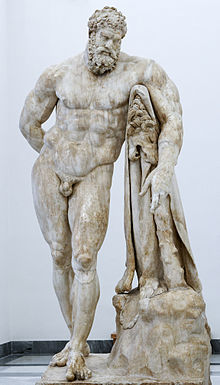مردانگی

مردانگی (انگریزی: Masculinity)، جسے مردانہ وجاہت یا مردانہ پن بھی کہا جاتا ہے، ان صفات، برتاؤ اورکرداروں کا مجموعہ ہے، جو لڑکوں اور آدمیوں سے متعلق ہیں۔ ایک سماجی نظام کے طور پر یہ ممتاز ہے اس تعریف سے جو حیاتیات کی رو سے جنس سے متعلق ہے۔[1][2] مردانگی کے معیارات ثقافتوں اور تاریخی ادوار میں مختلف رہے ہیں۔[3] یہ بھی بعض اقوال سے ثابت ہے کہ مرد و زن دونوں مردانہ صفات اور برتاؤ کا مظاہرہ کر سکتے ہیں۔[4]
مغربی دنیا میں مردانگی سے جڑی صفات میں طاقت، ہمت، آزادی، قیادت اور بار آوری شامل ہیں۔[5][6][7][8]
تاریخ میں عورتوں کا مردانگی سے متصف ہونا[ترمیم]
تاریخ میں کئی عورتیں ہمت و طاقت کا مظاہرہ کرتی ہوئی دیکھی گئی ہیں۔ اس وجہ سے ان کے کردار کو مردانہ کہا گیا ہے۔ ایسی ہی ایک شخصیت رانی لکشمی بائی تھی، جنھوں نے 1857ء میں ہندوستان کی پہلی جنگ آزادی میں لڑکر اپنا لوہا منوایا۔ ان کے میں ہندی میں کہا گیا ہے کہ خوب لڑی مردانی، ارے جھانسی واری رانی (ہندی: खूब लड़ी मरदानी, अरे झांसी वारी रानी[9]) تھی۔
مزید دیکھیے[ترمیم]
حوالہ جات[ترمیم]
- ↑ Ferrante, Joan (2008), "Gender and sexualities: with emphasis on gender ideals", in Joan Ferrante، مدیر (2010-01-01)۔ Sociology: a global perspective (7th ایڈیشن)۔ Belmont, California: Thomson Wadsworth۔ صفحہ: 269–272۔ ISBN 9780840032041
- ↑ "Gender, Women and Health: What do we mean by "sex" and "gender"?"۔ who.int۔ عالمی ادارہ صحت۔ 8 ستمبر 2014 میں اصل سے آرکائیو شدہ۔ اخذ شدہ بتاریخ 17 ستمبر 2014
- ↑ Michael S. Kimmel، Amy Aronson، مدیران (2004)۔ Men and Masculinities: A Social, Cultural, and Historical Encyclopedia, Volume 1۔ Santa Barbara, Calif.: ABC-CLIO۔ صفحہ: xxiii۔ ISBN 978-1-57-607774-0
- ↑ Halberstam, Judith (2004)۔ "'Female masculinity'"۔ $1 میں Michael S. Kimmel، Amy Aronson۔ Men and Masculinities: A Social, Cultural, and Historical Encyclopedia, Volume 1۔ Santa Barbara, Calif.: ABC-CLIO۔ صفحہ: 294–5۔ ISBN 978-1-57-607774-0
- ↑ Michael S. Kimmel (1994)۔ "Masculinity as Homophobia: Fear, Shame, and Silence in the Construction of Gender Identity"۔ Theorizing Masculinities۔ Thousand Oaks: SAGE Publications, Inc.۔ صفحہ: 119–141
- ↑ Mary Vetterling-Braggin (1982)۔ "Introduction"۔ "Femininity", "masculinity", and "androgyny": a modern philosophical discussion۔ Totowa, N.J: Littlefield, Adams۔ صفحہ: 6۔ ISBN 9780822603993۔
the [personality] theorist might classify a person as "masculine" if the person thought that person to have any or all of the following P-traits [personality traits] - GROUP Y TRAITS: strength of will, ambition, courage, independence, assertiveness, aggressiveness, ...
- ↑ Linda L. Carli (2001)۔ "Assertiveness"۔ $1 میں Judith Worell۔ Encyclopedia of women and gender: sex similarities and differences and the impact of society on gender, Volume 1۔ San Diego, California: Academic Press۔ صفحہ: 157–168۔ ISBN 9780122272462
- ↑ Thomas, R. Murray (2001), "Feminist perspectives", in R. Murray Thomas، مدیر (2001)۔ Recent theories of human development۔ Thousand Oaks, California: Sage۔ صفحہ: 248۔ ISBN 9780761922476۔
Gender feminists also consider traditional feminine traits (gentleness, modesty, humility, sacrifice, supportiveness, empathy, compassion, tenderness, nurturance, intuitiveness, sensitivity, unselfishness) morally superior to the traditional masculine traits (courage, strong will, ambition, independence, assertiveness, initiative, rationality and emotional control).
- ↑ खूब लड़ी मरदानी, अरे झांसी वारी रानी
